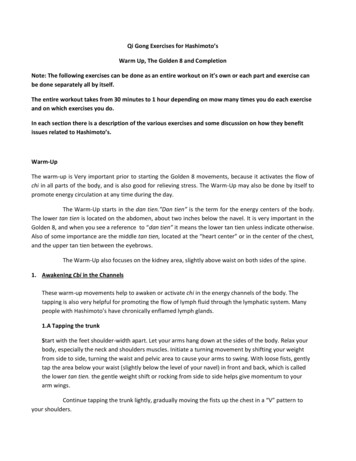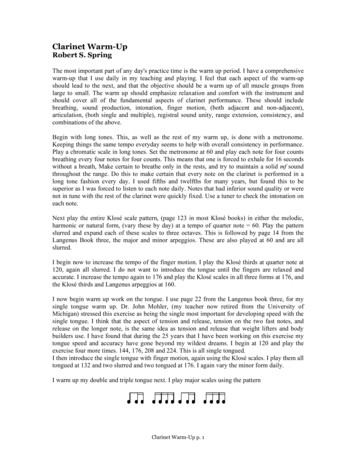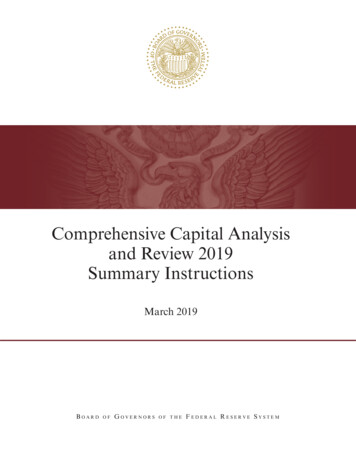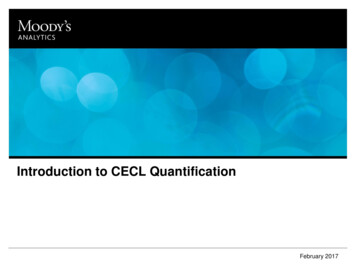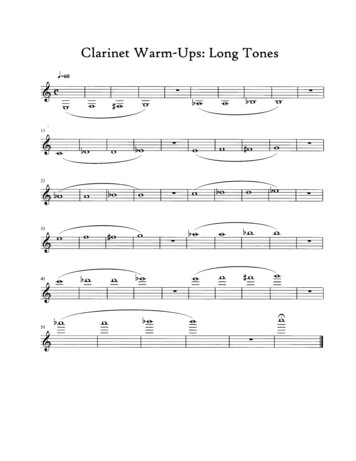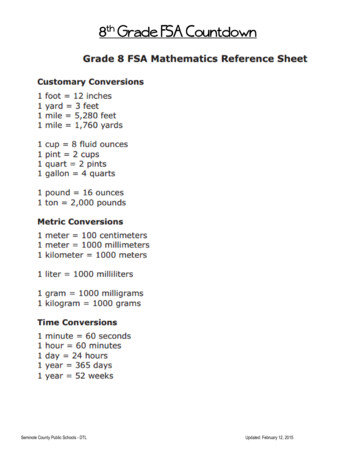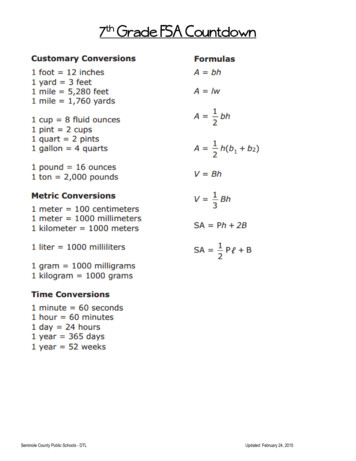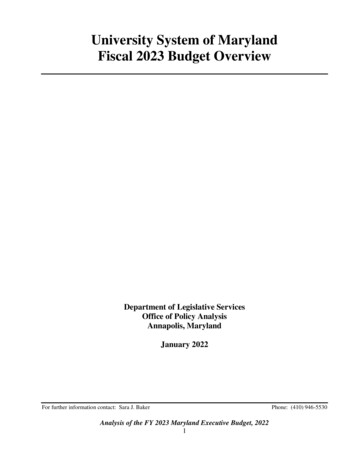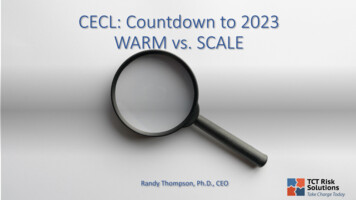
Transcription
CECL: Countdown to 2023WARM vs. SCALERandy Thompson, Ph.D., CEO
Defining Risk Possibility of incurring loss Vulnerability to a negative outcome
What is ACL? For financial institutions adopting the CECL methodology, an Allowance for Credit Losses (ACL)for loans replaces the former Allowance for Loan and Lease Losses (ALLL). Both methodologies provide for an estimate of uncollectible amounts maintained through avaluation account adjusted through charges to operating income.
FASB/NCUA Historical Perspective Evolution Accounting Standards Update (ASU) No. 2016-13, Financial Instruments — Credit Losses (Topic326): Measurement of Credit Losses on Financial Instruments – effective July 2016 Implementation for Credit Union extended to fiscal period beginning January 1, 2023 Introduction of the Weighted Average Remaining Maturity (WARM) method Federal Reserve issues Scale Model for Banks NCUA’s version of Scale Model for Credit Union still pending approval by the FinancialAccounting Standards Board.
What is CECL?Under CECL ACLs are estimates of the expected credit losses on financial assets using: historical credit loss experience on financial assets with similar risk characteristics, current conditions, reasonable and supportable forecasts, remaining cash flows over the contractual term of the financial assets.
Why CECL? Great Recession 2008 through 2011 Introduction of Qualitative and Environmental Factors Troubled Debt Restructures increase Real estate foreclosures increase Delinquency and loss ratios double More than 1,000 credit unions (12%) merged or liquidated GAO study cited “Incurred Loss Model” as significant factor in financial institution failures
Key Expectations From CECL? Can be done on a worksheet Perfection not expected on Day One may be fine tuned throughout 2023. Calculation of ACL can be done quarterly A high degree of management judgement still required First public disclosure will be on the March 31, 2023 Call Report
Expected Credit LossesRegression analysis identified the following factors as the primarypredictors of impending loss Deterioration of credit score Advanced delinquency Changing income or discretionary cash flow Changing economic conditions (relates to employment and cash flow) Loan to value (exacerbates loss but does not cause it)
Expected Credit LossesEconomic Factors that are statistical valid predictors of expected loss:1. Net Credit Change2. Advanced Delinquency3. Economic Stress Score Unemployment Foreclosure Bankruptcy
Expected Credit Loss FormulaRT (RC GA) (RIC REC)RT Total RiskRC Core RiskGA Grade AdjustmentRIC Individual Risk ChangeREC Economic Risk Change
WARM method vs. SCALE methodFASB and NCUA have approved and are promoting two primary CECL methodologies:1. Weighted Average Remaining Maturity (WARM)2. Scaled CECL Allowance Loss Estimator (SCALE)WARM allows for credit migration to be employed to differentiate between loans that are stable (no risk change)improving (increasing credit status) and deteriorating (decreasing credit status)SCALE is a static pool application that assumes all loans in a pool have similar riskTCT Risk Solutions has created CECL applications employing each of these methodologies to provide creditunions to choose the option that best suits their operations.It is important to note the impact of each methodology before making the choice.
TCTs WARM method explainedWARM allows for credit migration to be employed to differentiate between loans that are Stable (no risk change) Improving (increasing credit status) and Deteriorating (decreasing credit status).
WHAT ISCREDITMIGRATION& WHYSHOULD YOUCARE?
In this presentation wewill tell the story offour individuals thatrepresent credit unionmembers.Understanding theirstories will help usimprove our lendingand serve our membersbetter.Sit back and enjoy thestory ofCREDIT MIGRATION
RuthGood ole’ Ruthie has a high B credit score.She never gets too wild. She buys the same thingsmonth after month, she never overspends.Good Ole’ Ruthie is still a high B today!15
When Henry first came to your CreditUnion, he had A credit.HenrySeveral months ago, Henry lost hisjob, but he didn’t change his lifestyle.He started living off credit cards andtoday his credit score is a D.16
LizLiz is a credit newbie.Your credit union decides to take a chance andapprove her for a car loan.Over the past few months, she has built her creditup to an impressive A .17
Was down on his luck when your creditunion financed a car loan for him. Hiscredit was a D.However, his luck turned around and hewas able to find a job, make paymentson time and even save a buck or two.Today his credit score is an A.18John
One Year Ago Henry was an A Ruth was a B Liz had NO CREDIT John was a D
Here they aretoday Liz: NO CREDIT to A IMPROVED John: went from D to AIMPROVED Ruth: remains a BSTABLE Henry: dropped from A to DDETERIORATED
Key Factors for Calculating ACL with WARMBuilding on WARM and Credit Migration, we employ the following components to calculate a validACL. Remaining Life of Loan Remaining Life of Loan Loss Rate Valid Credit Grades Distribution of Loss rate across credit grades Management Adjustments (if applicable) Environmental Factors
Sample Incurred Calculation
Sample WARM Calculation
Let’s take a look at the B GroupA ABCDHenrys withIncreasing unsecured debtIncreasing loan balancesDecreasing credit scoresJohns withDecreasing or stable unsecured debtDecreasing or stable loan balancesIncreasing credit scores24
Examples of Changing Risk ExposureA member with a credit score in the A range requests an auto loan with an original balance of 20,000. 20,000 x 0.10% 20Borrower experiences a set back and his credit score drops to the C range the loss rate increases to0.50% 20,000 x 0.50% 100Borrower’s credit score continues to decline to the E range the loss rate on this loan increases to 8.13% 20,000 x 1.52% 304Result of the declining credit score is an increased Allowance of 284.
Examples of Changing Risk ExposureA member with a credit score in the D range applies for an auto loan with an original balance of 20,000. 20,000 x 1.49% 298Member up-migrates by improving the credit score into the B range, the loss rate reduces to 0.50% 20,000 x 0.50% 100Member continues to improve to A range, then the loss rate reduces to 0.35% 20,000 x 0.05% 10Results of the improving credit score is a reduction in allowance of 288.
Loss Comparison StudyVisa ActualQ1 1,949Q2 8,779Q3 3,799Q4 5,356Q5 6,724Q6 8,745Q7 58Q8 17,286Total 52,696Visa CM 1,048 3,467 1,650 2,329 2,719 4,650 58 8,250 24,171Unsecured ActualQ1 8,688Q2 17,460Q3 30,893Q4 4,478Q5 18,136Q6 57,121Q7 31,050Q8 59,274Total 227,100Unsecured CM 3,650 7,400 11,250 2,000 6,750 31,250 16,100 22,000 100,400Auto ActualQ1 2,720Q2 0Q4 22,346Q5 1,985 0 6,540 0Auto CM 550 0 0Q3Q6 0Q7 6,938Q8Total 5,099 39,088 0 2,500 1,500 11,09027
ALLL Comparison StudyAve Balance 860,739 860,739 860,739Loss RateQE BalanceALLL Required6.12% 914,173 55,967.162.81% 914,173 25,671.523.31% 914,173 30,295.64Loss History Ave BalanceUnsecured Actual 227,100 4,346,104Unsecured CM 100,400 4,346,104Difference 126,700 4,346,104Loss RateQE BalanceALLL Required5.23% 4,328,983 226,205.412.31% 4,328,983 100,004.492.92% 4,328,983 126,200.92Loss History Ave Balance 39,088 6,772,134 11,090 6,772,134 27,998 6,772,134Loss RateQE BalanceALLL Required0.58% 5,487,635 31,674.040.16% 5,487,635 8,986.510.41% 5,487,635 22,687.53Visa ActualVisa CMDifferenceAuto ActualAuto CMDifferenceLoss History 52,696 24,171 28,52528
Measuring is NOT ManagingWARM, with credit migration, provides an early warning sign for loans that are headed towarddelinquency and charge off. It is not enough to just measure your loss exposure TCT Portfolio Management tools help you control and thereby minimize the impact of CECL onyour Credit Union
TCTs WARM method explainedWARM allows for credit migration to be employed to differentiate between loans that are stable (no risk change)improving (increasing credit status) and deteriorating (decreasing credit status)Key Assumptions Underlying WARM with credit migration Risk of loss varies over ranges of credit scores Loss rates will vary across credit ranges Credit scores may vary over time resulting in changing risk A decreasing credit score is the most significant indicator of probable loss Early action can dramatically reduce your ACL requirement under CECL
WARM method vs. SCALE methodFASB and NCUA have approved and are promoting two primary CECL methodologies:1. Weighted Average Remaining Maturity (WARM)2. Scaled CECL Allowance Loss Estimator (SCALE)WARM allows for credit migration to be employed to differentiate between loans that are stable (no risk change)improving (increasing credit status) and deteriorating (decreasing credit status)SCALE is a static pool application that assumes all loans in a pool have similar riskTCT Risk Solutions has created CECL applications employing each of these methodologies to provide creditunions to choose the option that best suits their operations.It is important to note the impact of each methodology before making the choice.
TCTs SCALE method explainedSCALE is a static pool application that assumes all loans in a pool have similar riskKey Assumptions Underlying SCALE All Borrowers are considered similar Total losses are averaged against the total pool of loans Risk of Loss is considered equal across all loans in a pool
Key Factors for Calculating ACL with SCALEBuilding on SCALE, we employ the following components to calculate a valid ACL. Life of Loan Life of Loan loss rate Management Adjustments (if applicable) Environmental Factors
TCTs SCALE method explainedSCALE is a static pool application that assumes all loans in a pool have similar risk
90-99 Million Dollar Credit Union
200-250 Million Dollar Credit Union
WARM method vs. SCALE methodASSET SIZECURRENT ALLL REQ.WARM METHOD REQ.SCALE METHOD REQ.Equity Impact 223,317,113 157,008 167,520 256,157-0.04% 82,965,318 197,584 217,747 330,067-0.14% 69,908,287 126,892 165,581 261,758-0.14% 202,695,406 927,949 1,543,753 2,412,400-0.43% 21,102,923 33,515 49,111 75,728-0.13% 132,469,010 112,730 173,242 372,876-0.15% 32,825,780 89,673 162,155 299,183-0.42%
Basic Data Requirements: WARMGeneral Data (only needed during initial report set up or unless conditions change): Credit Grades and FICO Ranges List of Loan Codes with a brief description, and the loan pool that each loan code should beincluded in
Basic Data Requirements: WARMMonth-End Loan Data Monthly balances by pool for previous 12 months Loan Export File including:a.b.c.d.e.f.g.h.i.j.Account (Member) NumberLoan SuffixLoan Codes/Collateral Codes/Purpose CodesCurrent Balance (as of data period ended)Original Credit ScoreCurrent Credit ScoreOriginal Loan DateDays DelinquentInterest Rate (optional)Total Available Credit (optional)
Basic Data Requirements: WARMCharge off and Recovery DataCHARGE OFF DATA FOR PERVIOUS 12MONTHS INCLUDING:RECOVERY DATA FOR THE LAST 12 MONTHS:Account (Member) NumberAccount (Member) NumberLoan SuffixLoan SuffixLoan Codes/Collateral Codes/Purpose CodesLoan Codes/Collateral Codes/Purpose CodesCharge Off AmountRecovery AmountCharge Off DateRecovery DateOriginal FICO ScoreFICO Score at the time of Charge off (ifavailable)
Basic Data Requirements: WARMImpaired Loan ListA list of your impaired loans (ASC 310-10) from your most recent ALLL calculation. These loans should include allTDR's, Modifications, Bankruptcies, Repossessions, Foreclosures, and any other loans that are in the process ofbeing charged off but are still on your books. Please use the template provided below to enter your impaired loansinformation.a.b.c.d.e.f.g.h.i.Impairment Type (TDR, Delinquent loans, etc.)Account (Member) NumberLoan SuffixLoan Codes/Collateral Codes/Purpose CodesCurrent Balance (as of Date Period Ended)Days Delinquent1st Mortgage Balance if the loan is in a 2nd mortgage or HELOCCollateral Value (for unsecured loans leave blank)Provision Amount Provided by our Credit Union (if cell is left blank, Collateral Value calculation will be used)
Basic Data Requirements: SCALECredit Union provides to TCT on a quarterly basis: Individually identified loansRemaining data is collected from CU NCUAs 5300 call report
WARM Method More precise allowance calculation Measures impact of credit scorechanges Supports proactive management ofCONSlosses Early detection of deteriorating loans Requires more detailed data Requires more staff time for applicationPROS
SCALE Method Simple data collections Simple ACL calculations Less complex for smaller Credit UnionsCONS Higher ACL for more complex CUsPROS May inflate ACL requirement
Ask yourself these questions to determinewhich method works for you!1. Does my loan management system provide core reports that can be used to populate credit migrationanalyses?2. Does the credit union have adequate staffing to collect data and utilize the CM reports?If your answers to these questions are yes – consider WARM, if they are no - consider SCALE3. Is my loan portfolio more complex?4. Is my loan to share ratio in the higher percentage range?5. Would my credit union benefit from earlier detection of improving and deteriorating loans?If your answers to these questions are yes – consider WARM, if they are no - consider SCALE
Policy ImpactsIt will be imperative to edit your Allowance for Loan Loss policy so that is correctly reflects how your allowanceis calculated. We recommend including the following aspects in your policy: Responsibility and oversight Details and applications of calculation methodology ASC 450-20 Homogeneous pools ASC 310-10 Individually Identified Loans Environmental Factors (Q&E) Participation loan pools Loan loss identification Summary of reports and outputs Regulatory references
CONTACT US WITH QUESTIONS208-939-8366djensen@tctrisk.com
SCALE is a static pool application that assumes all loans in a pool have similar risk TCT Risk Solutions has created CECL applications employing each of these methodologies to provide credit unions to choose the option that best suits their operations. It is important to note the impact of each methodology before making the choice.
